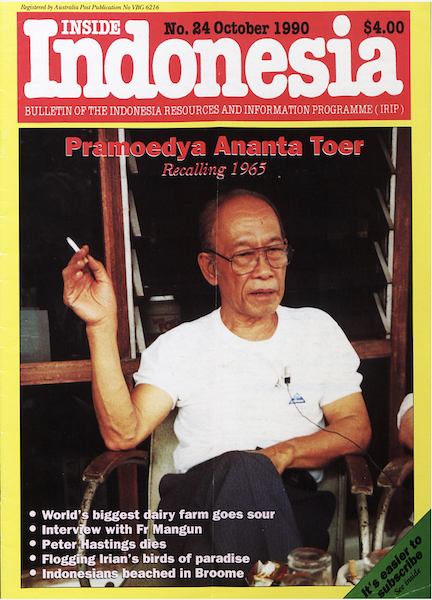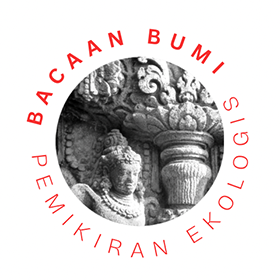Barbara Hatley
6th February this year marked the centenary of the birth of renowned, iconic Indonesian writer, Pramoedya Ananta Toer. Pramoedya is best known for his quartet of novels, This Earth of Mankind, Child of All Nations, Footsteps and House of Glass, describing the creation of the Indonesian nation. These works were written under the most difficult and stressful conditions while Pramoedya was imprisoned for ten years on the prison island of Buru for his leftist political sympathies and connections. Initially denied access to writing materials, Pramoedya kept the stories ‘alive’ by recounting them to other prisoners, who, when he finally was allowed to write, assisted him to produce the novels. After his release from prison in 1979 the novels were published, quickly banned by President Suharto’s New Order government, but circulated clandestinely and attracted great interest. Today Pramoedya’s fame continues to spread.
Pramoedya’s centenary was celebrated widely in Indonesia, rarely by institutions with government connections, instead largely by non-government organisations and activist groups, involving many young people. Celebratory events also took place internationally. In Melbourne, the Museum of Indonesian Arts organised a program discussing Pramoedya’s works. Three of the articles included in this edition, by Max Lane, Nathan Hollier and Barbara Hatley, were initially presented at this event. Other contributions are from scholars with great interest in and knowledge about Pramoedya’s work, Taufiq Hanafi and Nazarudin, and author Joel Whitney.
This special edition continues an ongoing discussion in Inside Indonesia of Pramoedya’s literary, cultural and political significance. In the first edition of the magazine published in 1983, Keith Foulcher mentions Pramoedya’s work in an article about Balinese poet Putu Oka Sukanta who, like Pramoedya, as a member of the Communist-linked cultural institute LEKRA was imprisoned for his leftist connections. Articles about Pramoedya by academics such as Pamela Allen, Adrian Vickers, Paul Tickell and Helen Jarvis, also Indonesian poet, writer and editor Goenawan Mohamad, and indeed translator of his works, Max Lane, have appeared over the years.
Pramoedya’s death in 2006 was marked by a special edition in his honour including contributions from Keith Foulcher, Pam Allen, Putu Oka, and writer, historian and current Director General of Culture Himar Farid.
This edition
In this edition, Max Lane focuses on the widespread celebration of Pramoedya’s centenary in Indonesia. While very few government institutions or universities were involved, trade unions and activist groups organised scores of events, attracting large crowds, particularly of young people. Many presumably were from the ‘dunia literasi’, members of communal and activist libraries, book groups and independent bookstores, who had encountered Pramoedya’s works there. Max described the atmosphere of such events as ‘full of the energy of creation and rebellion.’
Taufiq Hanafi describes and ‘assesses’ the celebration of Pramoedya’s centenary in Blora, Pramoedya’s hometown. Here there were widespread celebrations and unlike other locations, government institutions and officials were involved; the bupati (regent) and Minister of Culture as well as prominent artists and writers gave speeches. While some were impressive, Taufiq describes the bupati’s speech as ‘predictable…full of platitudes’, and overall the event ‘seemed rushed, truncated, half-hearted’. But such ceremonies were not Pramoedya’s domain anyway, Taufiq suggests – ‘he belonged in the margins, in the struggle, in the long arc of resistance’.
Barbara Hatley’s contribution also concerns Blora, but rather than contemporary events focuses on Pramoedya's Cerita Blora (Stories of Blora). In this book of short stories Pramoedya describes the experiences of the people of Blora, including his own family, during the period of tumultuous social change from the 1920s-1950s. Having had the opportunity to meet several of his family members on a visit to Blora in the early 1970s, she also discusses these meetings.
Nazarudin examines the use of digital memes - images, videos or sections of text circulated through social media - as a way of introducing Pramoedya’s work to new generations. He identifies three types of uses of Pram’s work, the serious intellectual work, ironic commentary on contemporary social and political conditions, and political symbol. Nazarudin suggests that Pramoedya’s centenary celebrations provide an ideal context for understanding memes related to his work, providing several examples.
Joel Whitney’s contribution describes Pramoedya’s release from Buru Island and the experiences which followed. After lengthy delay, two years after being told his name was ‘on the release list’, Pramoedya was finally able to return to Java; a fellow prisoner smuggling the manuscripts of the first two novels of the Buru quartet in his rucksack. The novels were published by the Hasta Mitra (Hands of Friends) publishing house. Although soon banned by the Suharto government they were widely read clandestinely and in English translation, and attracted great interest internationally, Pramoedya’s work was awarded the Fukuoka Prize in Japan, the Raman Magsaysay prize in the Philippines and PEN awards in London and New York. Late in life Pramoedya remained bitter about the deprivations and hardships he’d suffered during imprisonment but acknowledged that prison had in fact fostered his writing - facing oppression ‘I responded to the challenge.’
In his article, Nathan Hollier reflects on Pramoedya’s work and suggests it holds relevance for Australians today. In the Buru novels the Dutch are shown to ‘celebrate he achievements of European powers’ while ‘ignoring the contribution of Eastern thinkers and artists.’ Nathan asks how does this compare with Australia’s relationship with and attitudes towards European and Asian countries? And if democracy recognises ‘the inalienable value of all human beings’ can Australia really be called a democratic country?
Pramoedya and Inside Indonesia
A select bibliography
Editor: This list is based on a search conducted predominantly in the NLA digitised archive of Inside Indonesia, editions 1-46 (Dec 1983-Mar 1996). From number 46 onwards all editions are online.
- In the very first issue (Dec 1983), Keith Foulcher reviewed a series of Putu Oka Sukanta's poems and mentions Pramoedya’s work.
- In the context of the Tanjung Priok Incident (ed 4: Mar 1985).
- A semi-advertisement for Pram's books on sale (ed 6: Dec 1985).
- An article by Paul Tickell on Pram (ed 7: May 1986).
- An article by Helen Jarvis 'Pramoedya banned again' (ed 8: Oct 1988).
- Statement by Pram's publisher on the banning (ed 9: Dec 1986).
- Keith Foulcher review of 'Girl from the Coast' (ed 13: Dec 1987).
- On Pramoedya's clash with Rosihan Anwar (ed 15: Jul 1988).
- Review of Rumah Kaca by Claire Davidson and other mentions of Pramoedya (ed 16: Oct 1988).
- More responses to the banning of Pramoedya's work (ed 18: April 1989).

Edition 6 (December 1985) - Report on cases of UGM students charged with subversion for possessing Pramoedya's banned books (ed 19: Ap 1989).
- An interview with Pramoedya (possibly by Max Lane who edited edition 20: Oct 1989), (also in its original here) and on the Trials of Pram's publisher.
- Interview by Krishna Sen with Gareth Evans in which she mentions Max Lane not receiving funding due to his association with Pramoedya's banned books (ed 22: March 1990).
- Front Cover (ed 24:Oct 1990) features Pramoedya, and inside an interview with him by Gile Scrine and Max Lane. This edition also includes a review by Keith Foulcher of 'Cerita dari Blora’.
- Speech by Pramoedya on Human Rights Day 1992 (ed 34: March 1993).
- Article by Goenawan Mohammad (ed 44: Sept 95) on controversy re Pramoedya's Magasaysay award.
- Pam Allen's translation of Chapter 1 of Mute's Soliloquy and intro (ed 45: Dec 1995).
- An article by Adrian Vickers (ed 76: Oct-Dec 2003) that includes Inside Indonesia in his reflections on Pramoedya and Indonesian historiography.
- The publication in English of a speech Pramoedya gave in 2002 (ed 76: Oct-Dec 2003).
- Following Pram's death edition 88: Oct-Dec 2006 was dedicated to him, edited by Keith Foulcher. It includes a longer article by Keith, along with others by Putu Oka Sukanta and Hilmar Farid.














